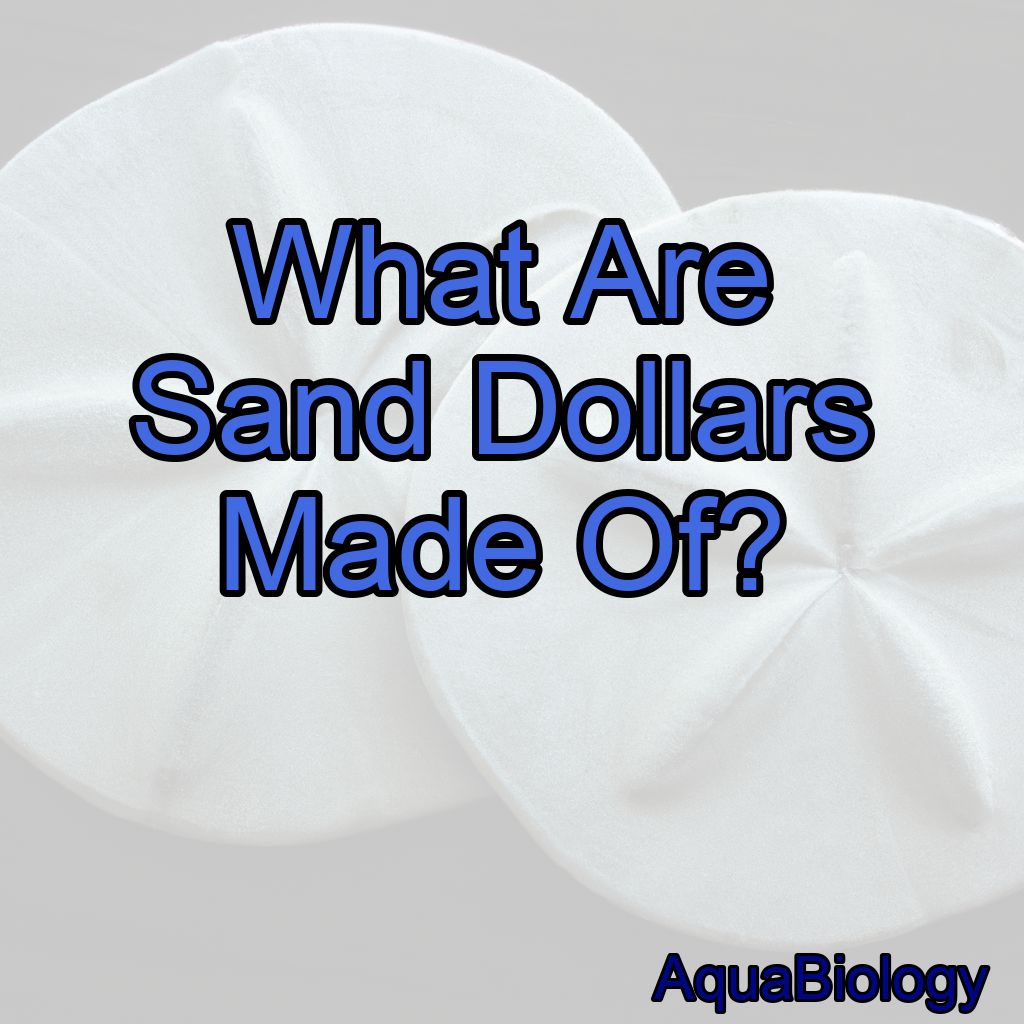Sand dollars are fascinating creatures that can be found on sandy beaches all around the world. As a marine biologist with a love for these beautiful creatures, I am often asked about what they are made of.
Sand dollars are made of calcium carbonate plates, forming their rigid exoskeleton.
In this blog post, I will explore the anatomy of sand dollars and the materials that they are made of.
Anatomy of a Sand Dollar
Sand dollars belong to the echinoderm family, which also includes sea stars, sea urchins, and brittle stars. They have a flattened disk-shaped body that is covered with a hard, bumpy exoskeleton.
This exoskeleton is made up of calcium carbonate plates that are connected by a meshwork of collagen fibers.
Sand dollars have a distinct five-pointed star pattern on their exoskeleton, which is where their name comes from.
They also have a mouth on the underside of their body, and a series of tube feet that they use for movement and feeding.
The Exoskeleton of a Sand Dollar
As mentioned previously, the exoskeleton of a sand dollar is made up of calcium carbonate plates that are connected by a meshwork of collagen fibers.
These plates are arranged in a radial pattern, with the five points of the star being the most prominent.
The exoskeleton of a sand dollar is not solid, but rather it is porous and allows water to flow through it.
This is important for the sand dollar’s respiration and feeding.
The pores in the exoskeleton are also used for the attachment of spines and tube feet.
The Role of Calcium Carbonate in Sand Dollar Exoskeletons

Calcium carbonate is a common material found in the exoskeletons of many marine organisms, including sand dollars, sea urchins, and coral.
It is a mineral that is formed when calcium, carbon, and oxygen combine in the presence of water.
Calcium carbonate is an important material for sand dollars because it gives their exoskeletons strength and rigidity. This is essential for their survival, as it allows them to protect themselves from predators and maintain their shape.
The Importance of Collagen in Sand Dollar Exoskeletons
Collagen is a protein that is found in many tissues throughout the body, including the skin, bones, and cartilage. In sand dollars, collagen fibers connect the calcium carbonate plates together, forming a strong and flexible exoskeleton.
Collagen is important for sand dollars because it allows their exoskeletons to withstand the stresses of the ocean environment. It also gives their exoskeletons some flexibility, which is important for movement and feeding.
The Evolution of Sand Dollar Exoskeletons
The exoskeletons of sand dollars have evolved over millions of years to become the complex structures that we see today.
Fossil records show that sand dollars have been around for at least 450 million years, and their exoskeletons have undergone many changes during this time.
One of the most interesting aspects of sand dollar evolution is the development of the five-pointed star pattern on their exoskeletons. Scientists believe that this pattern evolved as a way to distribute stress evenly across the exoskeleton, making it stronger and more resistant to damage.
Human Uses for Sand Dollar Exoskeletons
Sand dollar exoskeletons have been used by humans for a variety of purposes throughout history. In some cultures, they are considered to be lucky charms or symbols of peace and prosperity.
They are also used in crafts and jewelry making.
In addition, sand dollar exoskeletons have been used in scientific research. Scientists have studied the structure and composition of sand dollar exoskeletons to better understand the properties of calcium carbonate and collagen.
Conclusion
In conclusion, sand dollars are fascinating creatures that are made up of calcium carbonate plates and collagen fibers.
Their exoskeletons are strong, flexible, and porous, allowing them to survive in the ocean environment.
The evolution of their exoskeletons has led to the development of the distinctive five-pointed star pattern that we see today.
Here are five facts about sand dollar exoskeletons:
1. Sand dollar exoskeletons are made up of calcium carbonate plates and collagen fibers.
2. The exoskeletons are porous, allowing water to flow through for respiration and feeding.
3. The five-pointed star pattern on their exoskeletons evolved as a way to distribute stress evenly.
4. Sand dollar exoskeletons have been used by humans for crafts, jewelry making, and scientific research.
5. Sand dollars have been around for at least 450 million years, and their exoskeletons have undergone many changes during this time.
FAQs
What creates a sand dollar? Sand dollars are created by a type of sea urchin that has a hard, flattened exoskeleton.
The exoskeleton is made up of calcium carbonate plates that are arranged in a distinctive pattern resembling a flower.
Can you keep a sand dollar alive?
No, sand dollars cannot be kept alive outside of their natural habitat.
They require specific water conditions and a diet of small organisms found in the ocean.
Attempting to keep a sand dollar alive in captivity is not recommended and can be harmful to the animal.
What is inside of a sand dollar?
Inside of a sand dollar is a complex system of tiny spines, muscles, and organs that help it move, eat, and breathe.
What is the purpose of a sand dollar? I cannot speak on everyones behalf, as I don’t have personal beliefs or intentions.
However, sand dollars are marine animals that play a role in the ocean ecosystem by filtering sediment and plankton from the water and serving as a food source for other organisms.
Is it OK to hold a live sand dollar?
No, it is not OK to hold a live sand dollar.
Why are sand dollars so special?
Sand dollars are special because of their unique circular shape and intricate design, which consists of a series of small holes and patterns.
They are also interesting because they have a unique method of feeding and reproduction, and their skeletons are often found washed up on beaches as beautiful souvenirs.




